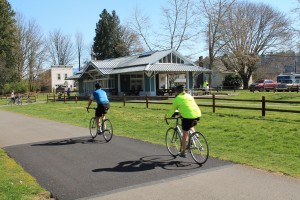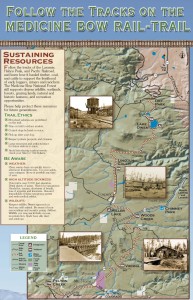The U.S. Supreme Court ruled 8-1 in favor of a group of Wyoming landowners on Monday in a case that could create a costly and major stumbling block for the rails-to-trails program.
The court ruled that when the federal government gave away land to private landowners under an 1875 law, and that land was later used for a railroad right-of-way, then that land reverts back to the private landowners after the railroads abandon that right-of-way.
Until now, that abandoned right-of-way stayed in public ownership and often became a bicycle trail.
The Rails-to-Trails Conservancy called the ruling “disappointing” and said its lawyers were analyzing it.
The nonprofit estimates there are more than 1,800 rail-trails in the US, covering more than 21,000 miles. It’s uncertain how many miles of trails are covered by the ruling.
Court observers say the ruling in Marvin M. Brandt Revocable Trust vs the United States could cost the federal government hundreds of millions of dollars in claims by private landowners. Once again, no one knows how many acres are affected by the ruling.
Kevin Mills, senior VP for policy and trail development for Rails-to-Trails Conservancy, told Reuters that the ruling would make certain trail projects “more vulnerable to litigation from adjoining landowners.”
Chief Justice John G. Roberts Jr., who wrote the opinion, said the ruling only applies to former railroad right-of-ways that lay across private parcels that the government had given away to private individuals under the General Railroad Right-of-Way Act of 1875.
Rails-to-Trails Conservancy explained that the decision does not apply to rail-trails that are “railbanked” corridors — those preserved under a federal law for future rail use by being converted to a trail in the interim. It could open up non-railbanked corridors to litigation, however.
The current case involves the continuation of the 21-mile Medicine Bow Rail Trail that was partially completed in southeastern Wyoming in 2007. The landowner, represented by the conservative Mountain States Legal Foundation, asserted that an abandoned Northern Pacific Railroad right-of-way through his property in southeastern Wyoming should revert to him and not the public.
Justice Sonia Sotomayor, the lone dissenter, said the decision “undermines the legality of thousands of miles of former rights of way that the public now enjoys as means of transportation and recreation.”
In oral arguments in front of the Supreme Court in January, the government attorneys couldn’t provide the justices with information on just how many acres would be impacted by the ruling.
That led Justice Stephen Breyer to make the ridiculous observation:
“For all I know, there is some right of way that goes through people’s houses, you know, and all of a sudden, they are going to be living in their house and suddenly a bicycle will run through it, which isn’t so bad, but I’m concerned about that, and your answer makes me more concerned.”
More coverage:
Lyle Denniston at the SCOTUS blog: Opinion analysis: Victory — and money — for landowners.
NPR: Family trust wins Supreme Court fight again bike trail
USA Today: Court ruling in land dispute could threaten bike trails
Rails-to-Trails Conservancy: Supreme Court hands down disappointing decision for trails in the U.S.



2 comments
1 pings
This ongoing never ending battle to preserve these routes for cyclists as railroads continue to abandon routes is disturbing. A great way to introduce beginning cyclists to develop and learn bicycle skills is via these trails once converted. They also create nice business opportunities for adjoining landowners.
These easements under the 1875 law were NEVER public access – these were easements for specific use by private rail companies, to encourage opening of the west to private development. The law was clear that after abandonment by the railroad, the easement ceased and full use returned to the underlying landowner. Those pesky landowners object to the government sweeping in and taking their land. Bike trails might be a noble cause, but no you can’t bike through my front lawn.
The Obama administration requested that SCOTUS take this case, hoping to sweep over 8,000 landowner’s legal claims into the trash can. Surprise, Surprise. Unless other arrangements are made, if you bike on an easement (rail, powerline), you are probably trespassing.
[…] See update, March 10, 2014 — “Supreme Court ruling deals uncertain future for rails-to-trails program.” […]